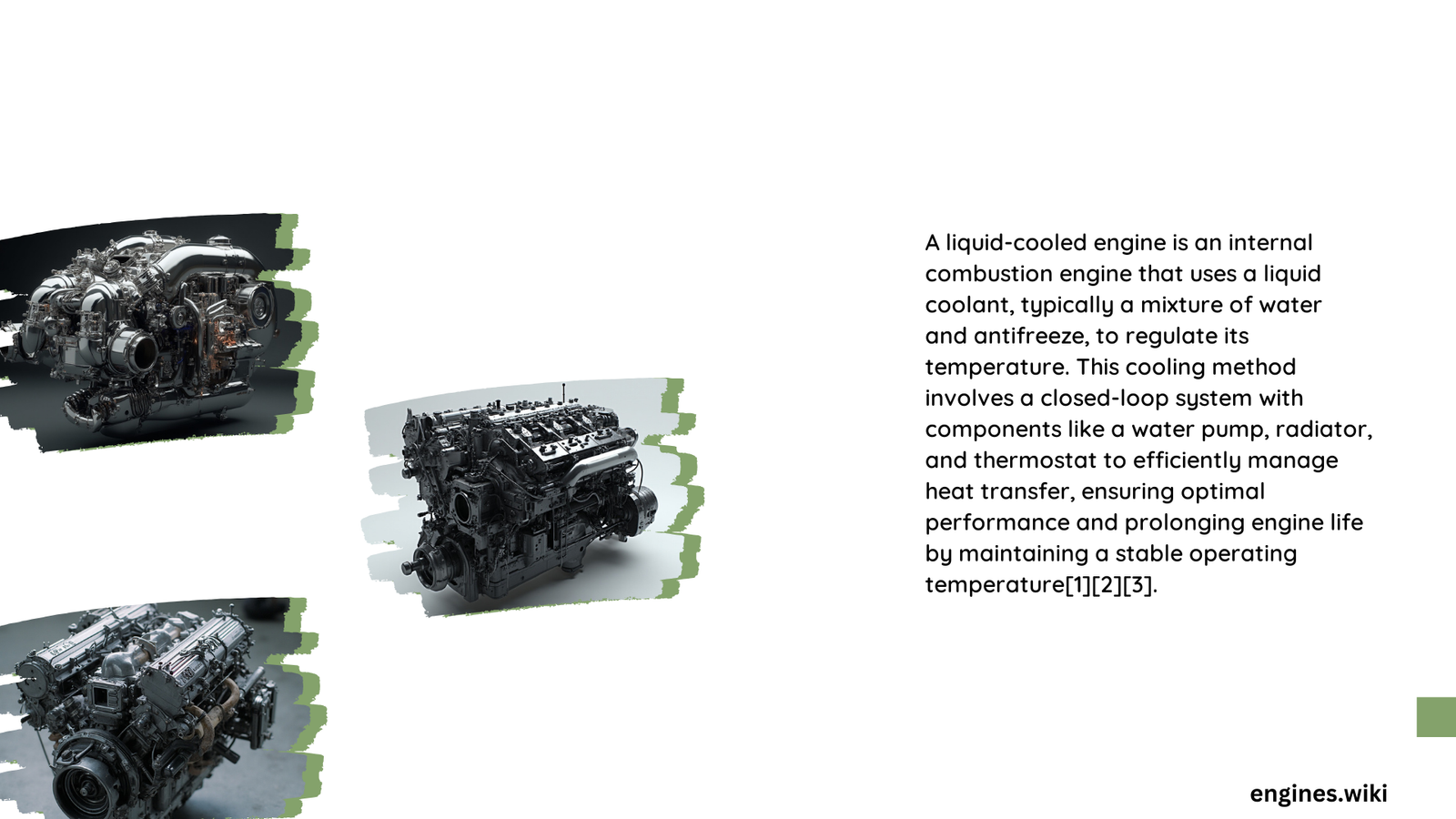A liquid cooled engine, also known as a water-cooled engine, is a type of internal combustion engine that uses a liquid coolant to regulate its temperature. This cooling system circulates a special fluid through passages in the engine block and cylinder head, absorbing heat and transferring it to the air via a radiator. Liquid cooling offers superior temperature control compared to air-cooled engines, allowing for higher power outputs and more efficient operation.
What Are the Key Components of a Liquid Cooled Engine?
The liquid cooling system in an engine consists of several crucial components:
- Radiator: A heat exchanger that dissipates heat from the coolant to the air.
- Water Pump: Circulates the coolant through the engine and cooling system.
- Thermostat: Controls coolant flow to maintain optimal engine temperature.
- Coolant: A specially formulated liquid that absorbs and transfers heat.
- Hoses: Connect various components of the cooling system.
- Fan: Assists in drawing air through the radiator for enhanced cooling.
How Does a Liquid Cooled Engine Work?

The operation of a liquid cooled engine follows these steps:
- The water pump circulates coolant through passages in the engine block and cylinder head.
- As the coolant flows, it absorbs heat from the engine components.
- The heated coolant then travels to the radiator.
- In the radiator, the coolant releases heat to the air passing through the radiator fins.
- The cooled liquid then returns to the engine to repeat the cycle.
- The thermostat regulates coolant flow to maintain optimal engine temperature.
What Are the Advantages of Liquid Cooled Engines?
Liquid cooled engines offer several benefits over their air-cooled counterparts:
- Better Temperature Control: Maintains more consistent engine temperatures.
- Higher Power Output: Can handle higher power outputs without overheating.
- Quieter Operation: Liquid cooling reduces engine noise.
- Longer Engine Life: More efficient cooling can lead to increased engine longevity.
- Improved Fuel Efficiency: Optimal temperature control can enhance fuel economy.
What Types of Coolants Are Used in Liquid Cooled Engines?
Coolants used in liquid cooled engines typically fall into two categories:
- Ethylene Glycol-Based Coolants:
- Most common type
- Excellent heat transfer properties
- Provides freeze protection
-
Requires proper disposal due to toxicity
-
Propylene Glycol-Based Coolants:
- Less toxic alternative
- Slightly less efficient in heat transfer
- Often used in environments where toxicity is a concern
How Do Liquid Cooled Engines Compare to Air-Cooled Engines?
| Aspect | Liquid Cooled Engines | Air-Cooled Engines |
|---|---|---|
| Cooling Efficiency | Higher | Lower |
| Temperature Control | More precise | Less precise |
| Power Output | Can handle higher outputs | Limited by cooling capacity |
| Noise Level | Quieter | Louder |
| Maintenance | More complex | Simpler |
| Weight | Heavier | Lighter |
| Cost | Generally higher | Generally lower |
What Are the Maintenance Requirements for Liquid Cooled Engines?
Proper maintenance of liquid cooled engines includes:
- Regular coolant level checks
- Periodic coolant replacement according to manufacturer specifications
- Inspection of hoses and connections for leaks
- Radiator cleaning to ensure optimal heat dissipation
- Thermostat functionality checks
- Water pump inspection and replacement when necessary
How Do Environmental Factors Affect Liquid Cooled Engines?
Environmental factors can significantly impact the performance of liquid cooled engines:
- Extreme Cold: May require antifreeze properties in the coolant to prevent freezing.
- High Temperatures: Can stress the cooling system, requiring efficient heat dissipation.
- Altitude: Lower air density at high altitudes can affect cooling efficiency.
- Humidity: High humidity can reduce the air’s capacity to absorb heat from the radiator.
What Are the Latest Innovations in Liquid Cooling Technology?
Recent advancements in liquid cooling technology include:
- Electric Water Pumps: Offer more precise control over coolant flow.
- Advanced Coolant Formulations: Provide better heat transfer and corrosion protection.
- Dual-Circuit Cooling Systems: Allow for separate cooling of the engine block and cylinder head.
- Thermal Management Modules: Integrate various cooling system components for improved efficiency.
- Nanofluids: Experimental coolants with enhanced heat transfer properties.
How Do Liquid Cooled Engines Contribute to Vehicle Efficiency?
Liquid cooled engines enhance vehicle efficiency through:
- Optimal Operating Temperatures: Maintain engine efficiency across various operating conditions.
- Reduced Friction: Proper cooling minimizes thermal expansion and reduces internal friction.
- Improved Power-to-Weight Ratio: Efficient cooling allows for more compact engine designs.
- Enhanced Turbocharging: Better temperature control supports more efficient turbocharger operation.
- Integrated Heat Recovery Systems: Some advanced systems use engine heat for cabin warming or other purposes.
In conclusion, the liquid cooled engine definition encompasses a sophisticated system designed to maintain optimal engine temperatures. This technology has become the standard in most modern vehicles due to its superior performance, efficiency, and adaptability to various operating conditions.
References:
1. Air Cooled vs Liquid Cooled Engine – BISON Machinery
2. Water-cooled engine – All industrial manufacturers – DirectIndustry
3. Air-Cooled Engine vs. Liquid-Cooled Engine: Advantages and Disadvantages
